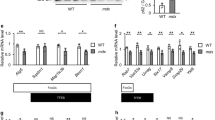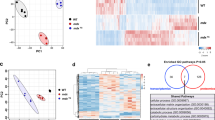Abstract
Inactivation of dystrophin gene is the primary cause of Duchenne muscular dystrophy (DMD) in humans and mdx mice. However, the underpinning mechanisms, which govern the pathogenesis of dystrophin-deficient skeletal muscle, remain poorly understood. We have previously reported activation of mitogen-activated protein kinases (MAPK), nuclear factor-kappa B (NF-κB), and phosphatidyl-inositol 3-kinase/Akt (PI3K/Akt) signaling pathways in diaphragm muscle of mdx mice. In this study, using a protein–DNA array-based approach, we have investigated the activation of 345 transcription factors in diaphragm muscle of 6-week old normal and dystrophin-deficient mdx mice. Our data demonstrate increased activation of a number nuclear transcription factors including AP1, HFH-3, PPARα, c.myb BP, ETF, Fra-1/JUN, kBF-A, N-rasBP, lactoferrin BP, Myb(2), EBP40_45, EKLF(1), p53(2), TFEB, Myc-Max; c-Rel; E2, ISRE; NF-kB; Stat1 p84/p91, Antioxidant RE, EVI-1, Stat3, AP3, p53, Stat4, AP4, HFH-1, FAST-1, Pax-5, and Beta-RE in the diaphragm muscle of mdx mice compared to corresponding normal mice. The level of activation for p53 was highest among all the transcription factors studied. Furthermore, higher activation of p53 in diaphragm muscle of mdx mice was associated with its increased phosphorylation and nuclear translocation. Collectively, our data suggest that the primary deficiency of dystrophin leads to the aberrant activation of nuclear transcription factors which might further contribute to muscle pathogenesis in mdx mice.




Similar content being viewed by others
Abbreviations
- AP-1:
-
Activator protein-1
- DMD:
-
Duchenne muscular dystrophy
- EMSA:
-
Electrophoretic mobility shift assay
- NF-κB:
-
Nuclear factor-kappa B
- PI3K:
-
Phosphatidyl-inositol 3-kinase
- STAT:
-
Signal transduction and activator of transcription
References
Ervasti JM, Ohlendieck K, Kahl SD et al (1990) Deficiency of a glycoprotein component of the dystrophin complex in dystrophic muscle. Nature 345:315–319
Chelly J, Kaplan JC, Maire P et al (1998) Transcription of the dystrophin gene in human muscle and non-muscle tissue. Nature 333:858–860
Hoffman EP, Brown RH Jr, Kunkel LM (1987) Dystrophin: the protein product of the Duchenne muscular dystrophy locus. Cell 51:919–928
Straub V, Campbell KP (1997) Muscular dystrophies and the dystrophin–glycoprotein complex. Curr Opin Neurol 10:168–175
Straub V, Rafael JA, Chamberlain JS et al (1997) Animal models for muscular dystrophy show different patterns of sarcolemmal disruption. J Cell Biol 139:375–385
Spencer MJ, Montecino-Rodriguez E, Dorshkind K et al (2001) Helper (CD4(+)) and cytotoxic (CD8(+)) T cells promote the pathology of dystrophin-deficient muscle. Clin Immunol 98:235–243
Chen YW, Zhao P, Borup R et al (2000) Expression profiling in the muscular dystrophies: identification of novel aspects of molecular pathophysiology. J Cell Biol 151:1321–1336
Tidball JG, Wehling-Henricks M (2004) Evolving therapeutic strategies for Duchenne muscular dystrophy: targeting downstream events. Pediatr Res 56:831–841
Khurana TS, Davies KE (2003) Pharmacological strategies for muscular dystrophy. Nat Rev Drug Discov 2:379–390
Haslett JN, Sanoudou D, Kho AT et al (2002) Gene expression comparison of biopsies from Duchenne muscular dystrophy (DMD) and normal skeletal muscle. Proc Natl Acad Sci USA 99:15000–15005
Porter JD, Khanna S, Kaminski HJ (2002) A chronic inflammatory response dominates the skeletal muscle molecular signature in dystrophin-deficient mdx mice. Hum Mol Genet 11:263–272
Porter JD, Merriam AP, Leahy P et al (2003) Dissection of temporal gene expression signatures of affected and spared muscle groups in dystrophin-deficient (mdx) mice. Hum Mol Genet 12:1813–1821
Kumar A, Boriek AM (2003) Mechanical stress activates the nuclear factor-kappaB pathway in skeletal muscle fibers: a possible role in Duchenne muscular dystrophy. FASEB J 17:386–396
Kumar A, Khandelwal N, Malya R et al (2004) Loss of dystrophin causes aberrant mechanotransduction in skeletal muscle fibers. FASEB J 18:102–113
Dogra C, Changotra H, Wergedal JE et al (2006) Regulation of phosphatidylinositol 3-kinase (PI3K)/Akt and nuclear factor-kappa B signaling pathways in dystrophin-deficient skeletal muscle in response to mechanical stretch. J Cell Physiol 208:575–585
Messina S, Altavilla D, Aguennouz M et al (2006) Lipid peroxidation inhibition blunts nuclear factor-kappaB activation, reduces skeletal muscle degeneration, and enhances muscle function in mdx mice. Am J Pathol 168:918–926
Carlson CG, Samadi A, Siegel A (2005) Chronic treatment with agents that stabilize cytosolic IkappaB-alpha enhances survival and improves resting membrane potential in MDX muscle fibers subjected to chronic passive stretch. Neurobiol Dis 20:719–730
Messina S, Bitto A, Aguennouz M et al (2006) Nuclear factor kappa-B blockade reduces skeletal muscle degeneration and enhances muscle function in mdx mice. Exp Neurol 198:234–241
Acharyya S, Villalta SA, Bakkar N et al (2007) Interplay of IKK/NF-kappaB signaling in macrophages and myofibers promotes muscle degeneration in Duchenne muscular dystrophy. J Clin Invest 117:889–901
Whitmarsh AJ, Davis RJ (2000) Regulation of transcription factor function by phosphorylation. Cell Mol Life Sci 57:1172–1183
Scheidereit C (1996) Transcription factors: important tools and targets for molecular medicine. J Mol Med 74:707–709
Kumar A, Chaudhry I, Reid MB et al (2002) Distinct signaling pathways are activated in response to mechanical stress applied axially and transversely to skeletal muscle fibers. J Biol Chem 277:46493–46503
Dogra C, Changotra H, Mohan S et al (2006) Tumor necrosis factor-like weak inducer of apoptosis inhibits skeletal myogenesis through sustained activation of nuclear factor-kappaB and degradation of MyoD protein. J Biol Chem 281:10327–10336
Woods DB, Vousden KH (2001) Regulation of p53 function. Exp Cell Res 264:56–66
Luo J, Li M, Tang Y et al (2004) Acetylation of p53 augments its site-specific DNA binding both in vitro and in vivo. Proc Natl Acad Sci USA 101:2259–2264
Rodriguez MS, Desterro JM, Lain S et al (1999) SUMO-1 modification activates the transcriptional response of p53. EMBO J 18:6455–6461
Rando TA (2001) The dystrophin–glycoprotein complex, cellular signaling, and the regulation of cell survival in the muscular dystrophies. Muscle Nerve 24:1575–94
Engvall E, Wewer UM (2003) The new frontier in muscular dystrophy research: booster genes. FASEB J 17:1579–1584
Latchman DS (2000) Transcription factors as potential targets for therapeutic drugs. Curr Pharm Biotechnol 1:57–61
Chen YW, Nagaraju K, Bakay M et al (2005) Early onset of inflammation and later involvement of TGFbeta in Duchenne muscular dystrophy. Neurology 65:826–834
Monici MC, Aguennouz M, Mazzeo A et al (2003) Activation of nuclear factor-kappaB in inflammatory myopathies and Duchenne muscular dystrophy. Neurology 60:993–997
Jiang X, Norman M, Roth L et al (2004) Protein–DNA array-based identification of transcription factor activities regulated by interaction with the glucocorticoid receptor. J Biol Chem 279:38480–38485
Disatnik MH, Dhawan J, Yu Y (1998) Evidence of oxidative stress in mdx mouse muscle: studies of the pre-necrotic state. J Neurol Sci 161:77–84
Spencer MJ, Tidball JG (2001) Do immune cells promote the pathology of dystrophin-deficient myopathies? Neuromuscul Disord 11:556–564
Wehling-Henricks M, Lee JJ, Tidball JG (2004) Prednisolone decreases cellular adhesion molecules required for inflammatory cell infiltration in dystrophin-deficient skeletal muscle. Neuromuscul Disord 14:483–490
Galvagni F, Cantini M, Oliviero S (2002) The utrophin gene is transcriptionally up-regulated in regenerating muscle. J Biol Chem 277:19106–19113
Perkins KJ, Davies KE (2003) Ets, Ap-1 and GATA factor families regulate the utrophin B promoter: potential regulatory mechanisms for endothelial-specific expression. FEBS Lett 538:168–172
Lane DP (1992) Cancer. p53, guardian of the genome. Nature 358:15–16
Kastan MB, Onyekwere O, Sidransky D et al (1991) Participation of p53 protein in the cellular response to DNA damage. Cancer Res 51:6304–6311
Siu PM, Pistilli EE, Murlasits Z et al (2006) Hindlimb unloading increases muscle content of cytosolic but not nuclear Id2 and p53 proteins in young adult and aged rats. J Appl Physiol 100:907–916
Siu PM, Alway SE (2005) Id2 and p53 participate in apoptosis during unloading-induced muscle atrophy. Am J Physiol Cell Physiol 288:C1058–C1073
Siu PM, Alway SE (2005) Subcellular responses of p53 and Id2 in fast and slow skeletal muscle in response to stretch-induced overload. J Appl Physiol 99:1897–1904
Ohnishi T, Takahashi A, Wang X (1999) Accumulation of a tumor suppressor p53 protein in rat muscle during a space flight. Mutat Res 430:271–274
Siu PM, Alway SE (2005) Mitochondria-associated apoptotic signalling in denervated rat skeletal muscle. J Physiol 565:309–323
Tergaonkar V, Perkins ND (2007) p53 and NF-kappaB crosstalk: IKKalpha tips the balance. Mol Cell 26:158–159
Bohuslav J, Chen LF, Kwon H et al (2004) p53 induces NF-kappaB activation by an IkappaB kinase-independent mechanism involving phosphorylation of p65 by ribosomal S6 kinase 1. J Biol Chem 279:26115–26125
Huang WC, Ju TK, Hung MC et al (2007) Phosphorylation of CBP by IKKalpha promotes cell growth by switching the binding preference of CBP from p53 to NF-kappaB. Mol Cell 26:75–87
Acknowledgements
This study was supported by funding from the Muscular Dystrophy Association and National Institute of Health (RO1 AG029623) to AK.
Author information
Authors and Affiliations
Corresponding author
Electronic supplementary material
Below is the link to the electronic supplementary material.
Rights and permissions
About this article
Cite this article
Dogra, C., Srivastava, D.S. & Kumar, A. Protein–DNA array-based identification of transcription factor activities differentially regulated in skeletal muscle of normal and dystrophin-deficient mdx mice. Mol Cell Biochem 312, 17–24 (2008). https://doi.org/10.1007/s11010-008-9716-6
Received:
Accepted:
Published:
Issue Date:
DOI: https://doi.org/10.1007/s11010-008-9716-6




